Case Study: Visitor Behaviour & Crowd Management Challenges
VerifiedAdded on 2023/06/07
|13
|4221
|457
Case Study
AI Summary
This case study delves into the complexities of visitor behaviour and crowd management within the tourism sector, specifically focusing on the challenges faced in Phuket, Thailand, due to increasing tourist numbers and their impact on local communities. It examines the conflicting interests of various stakeholders, including local communities, game park management, and government authorities. The analysis utilizes the ABCDEFG-OMO framework to explore potential solutions, emphasizing the importance of stakeholder coordination, sustainable tourism practices, and addressing the concerns of local residents regarding potential relocation and environmental impact. Assumptions are evaluated, and relevant research is cited to provide a comprehensive understanding of the challenges and potential strategies for mitigating conflicts and promoting harmonious coexistence between tourism and local communities. The document is available on Desklib, a platform offering a wealth of study resources and solved assignments for students.
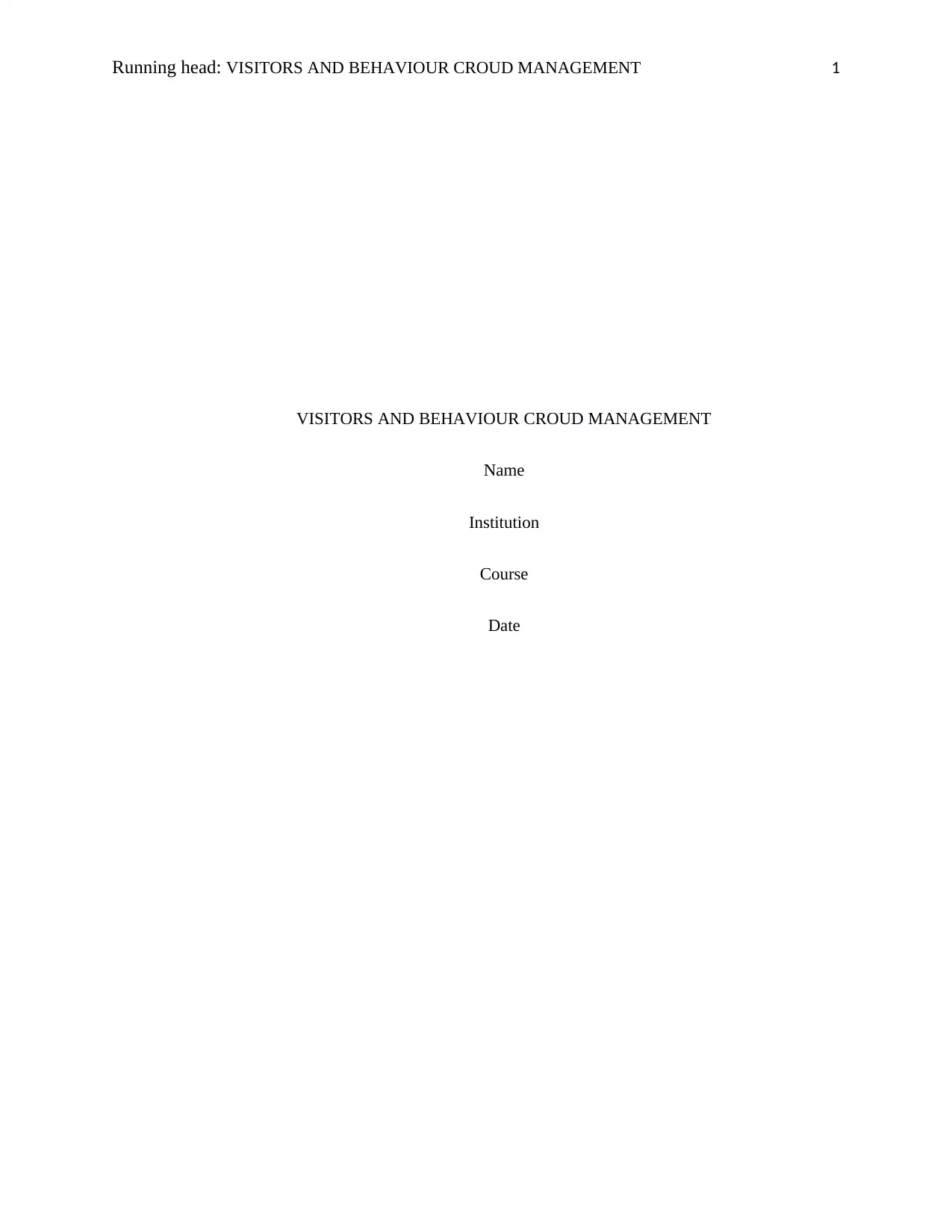
Running head: VISITORS AND BEHAVIOUR CROUD MANAGEMENT 1
VISITORS AND BEHAVIOUR CROUD MANAGEMENT
Name
Institution
Course
Date
VISITORS AND BEHAVIOUR CROUD MANAGEMENT
Name
Institution
Course
Date
Paraphrase This Document
Need a fresh take? Get an instant paraphrase of this document with our AI Paraphraser
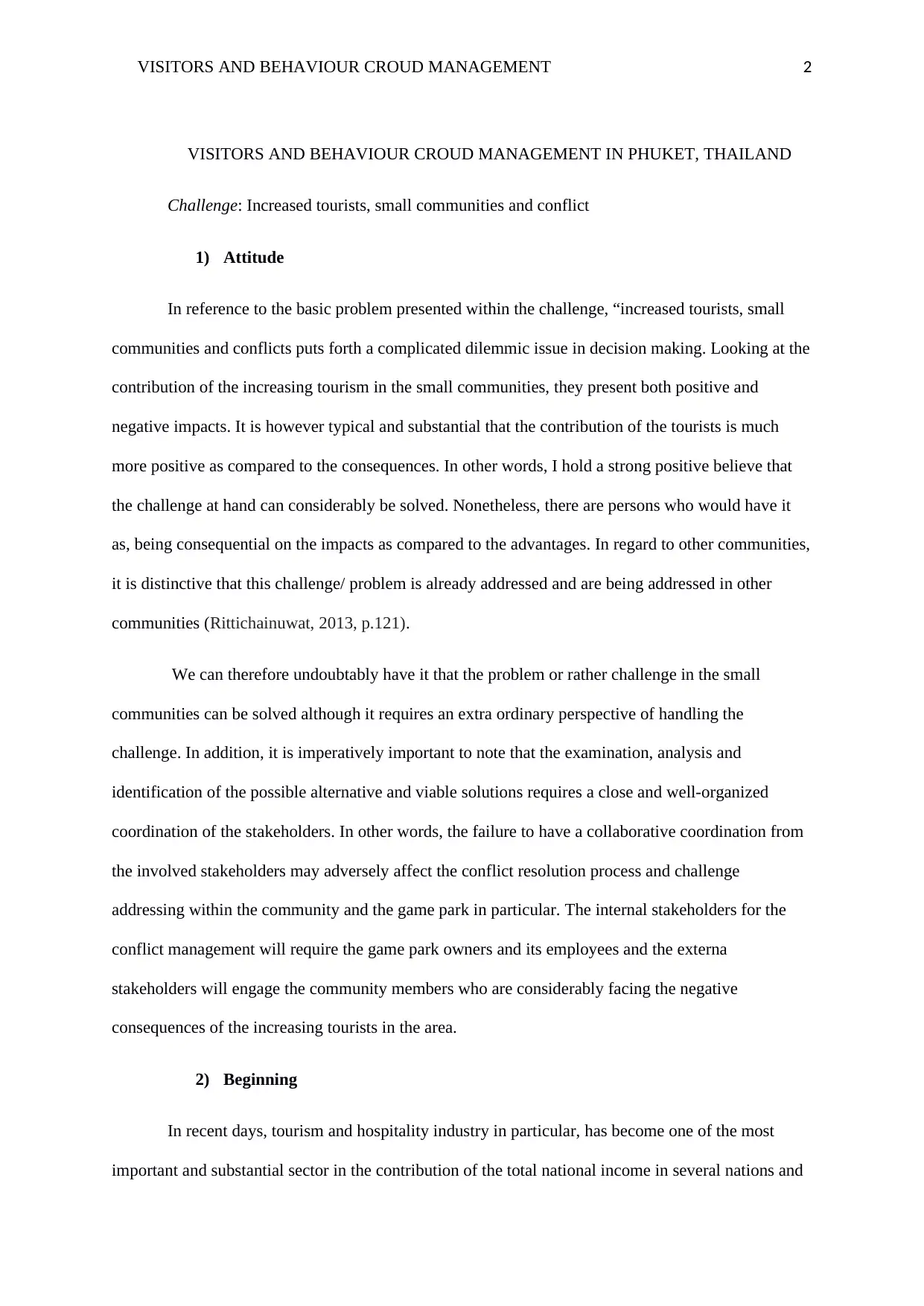
VISITORS AND BEHAVIOUR CROUD MANAGEMENT 2
VISITORS AND BEHAVIOUR CROUD MANAGEMENT IN PHUKET, THAILAND
Challenge: Increased tourists, small communities and conflict
1) Attitude
In reference to the basic problem presented within the challenge, “increased tourists, small
communities and conflicts puts forth a complicated dilemmic issue in decision making. Looking at the
contribution of the increasing tourism in the small communities, they present both positive and
negative impacts. It is however typical and substantial that the contribution of the tourists is much
more positive as compared to the consequences. In other words, I hold a strong positive believe that
the challenge at hand can considerably be solved. Nonetheless, there are persons who would have it
as, being consequential on the impacts as compared to the advantages. In regard to other communities,
it is distinctive that this challenge/ problem is already addressed and are being addressed in other
communities (Rittichainuwat, 2013, p.121).
We can therefore undoubtably have it that the problem or rather challenge in the small
communities can be solved although it requires an extra ordinary perspective of handling the
challenge. In addition, it is imperatively important to note that the examination, analysis and
identification of the possible alternative and viable solutions requires a close and well-organized
coordination of the stakeholders. In other words, the failure to have a collaborative coordination from
the involved stakeholders may adversely affect the conflict resolution process and challenge
addressing within the community and the game park in particular. The internal stakeholders for the
conflict management will require the game park owners and its employees and the externa
stakeholders will engage the community members who are considerably facing the negative
consequences of the increasing tourists in the area.
2) Beginning
In recent days, tourism and hospitality industry in particular, has become one of the most
important and substantial sector in the contribution of the total national income in several nations and
VISITORS AND BEHAVIOUR CROUD MANAGEMENT IN PHUKET, THAILAND
Challenge: Increased tourists, small communities and conflict
1) Attitude
In reference to the basic problem presented within the challenge, “increased tourists, small
communities and conflicts puts forth a complicated dilemmic issue in decision making. Looking at the
contribution of the increasing tourism in the small communities, they present both positive and
negative impacts. It is however typical and substantial that the contribution of the tourists is much
more positive as compared to the consequences. In other words, I hold a strong positive believe that
the challenge at hand can considerably be solved. Nonetheless, there are persons who would have it
as, being consequential on the impacts as compared to the advantages. In regard to other communities,
it is distinctive that this challenge/ problem is already addressed and are being addressed in other
communities (Rittichainuwat, 2013, p.121).
We can therefore undoubtably have it that the problem or rather challenge in the small
communities can be solved although it requires an extra ordinary perspective of handling the
challenge. In addition, it is imperatively important to note that the examination, analysis and
identification of the possible alternative and viable solutions requires a close and well-organized
coordination of the stakeholders. In other words, the failure to have a collaborative coordination from
the involved stakeholders may adversely affect the conflict resolution process and challenge
addressing within the community and the game park in particular. The internal stakeholders for the
conflict management will require the game park owners and its employees and the externa
stakeholders will engage the community members who are considerably facing the negative
consequences of the increasing tourists in the area.
2) Beginning
In recent days, tourism and hospitality industry in particular, has become one of the most
important and substantial sector in the contribution of the total national income in several nations and
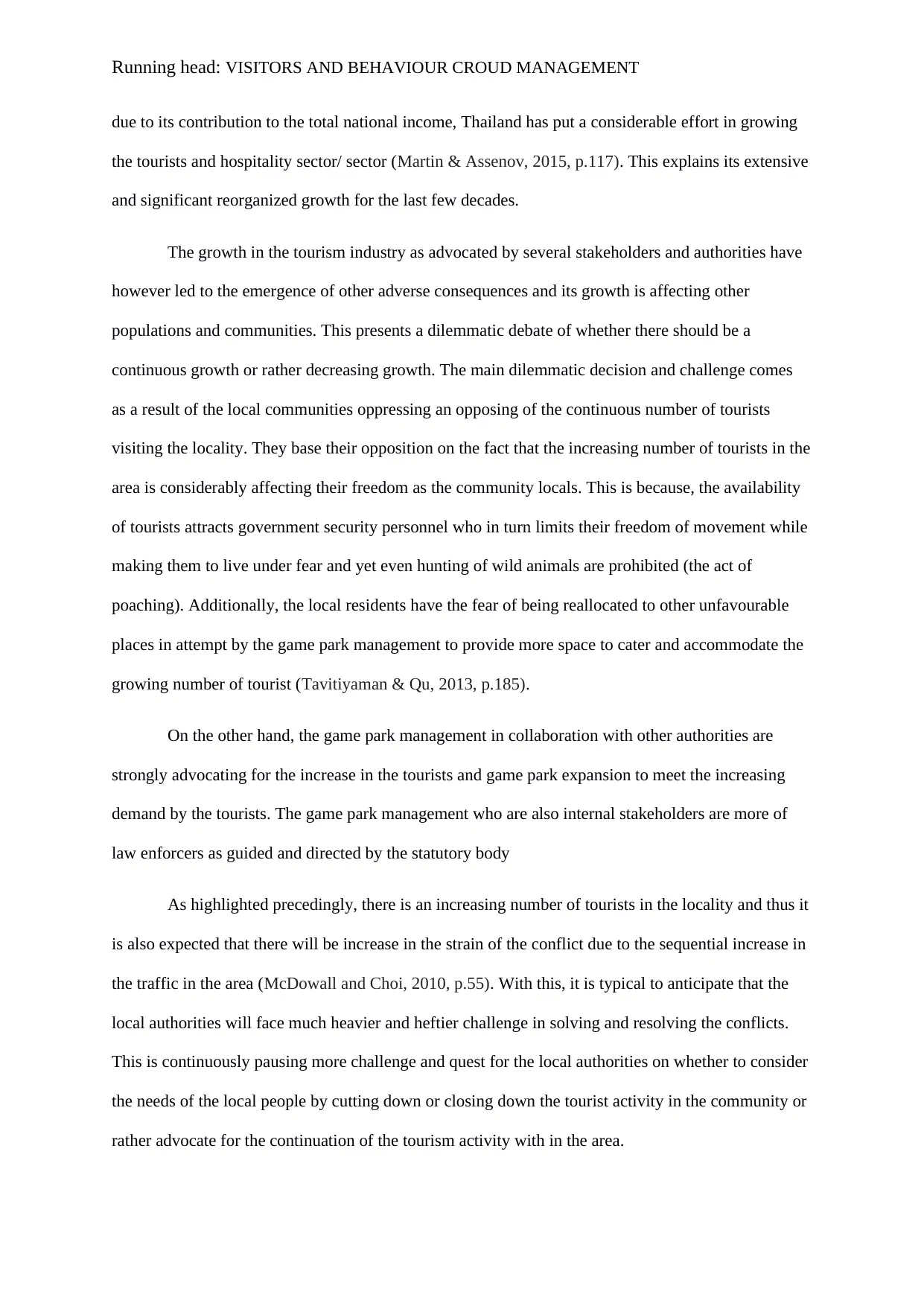
Running head: VISITORS AND BEHAVIOUR CROUD MANAGEMENT
due to its contribution to the total national income, Thailand has put a considerable effort in growing
the tourists and hospitality sector/ sector (Martin & Assenov, 2015, p.117). This explains its extensive
and significant reorganized growth for the last few decades.
The growth in the tourism industry as advocated by several stakeholders and authorities have
however led to the emergence of other adverse consequences and its growth is affecting other
populations and communities. This presents a dilemmatic debate of whether there should be a
continuous growth or rather decreasing growth. The main dilemmatic decision and challenge comes
as a result of the local communities oppressing an opposing of the continuous number of tourists
visiting the locality. They base their opposition on the fact that the increasing number of tourists in the
area is considerably affecting their freedom as the community locals. This is because, the availability
of tourists attracts government security personnel who in turn limits their freedom of movement while
making them to live under fear and yet even hunting of wild animals are prohibited (the act of
poaching). Additionally, the local residents have the fear of being reallocated to other unfavourable
places in attempt by the game park management to provide more space to cater and accommodate the
growing number of tourist (Tavitiyaman & Qu, 2013, p.185).
On the other hand, the game park management in collaboration with other authorities are
strongly advocating for the increase in the tourists and game park expansion to meet the increasing
demand by the tourists. The game park management who are also internal stakeholders are more of
law enforcers as guided and directed by the statutory body
As highlighted precedingly, there is an increasing number of tourists in the locality and thus it
is also expected that there will be increase in the strain of the conflict due to the sequential increase in
the traffic in the area (McDowall and Choi, 2010, p.55). With this, it is typical to anticipate that the
local authorities will face much heavier and heftier challenge in solving and resolving the conflicts.
This is continuously pausing more challenge and quest for the local authorities on whether to consider
the needs of the local people by cutting down or closing down the tourist activity in the community or
rather advocate for the continuation of the tourism activity with in the area.
due to its contribution to the total national income, Thailand has put a considerable effort in growing
the tourists and hospitality sector/ sector (Martin & Assenov, 2015, p.117). This explains its extensive
and significant reorganized growth for the last few decades.
The growth in the tourism industry as advocated by several stakeholders and authorities have
however led to the emergence of other adverse consequences and its growth is affecting other
populations and communities. This presents a dilemmatic debate of whether there should be a
continuous growth or rather decreasing growth. The main dilemmatic decision and challenge comes
as a result of the local communities oppressing an opposing of the continuous number of tourists
visiting the locality. They base their opposition on the fact that the increasing number of tourists in the
area is considerably affecting their freedom as the community locals. This is because, the availability
of tourists attracts government security personnel who in turn limits their freedom of movement while
making them to live under fear and yet even hunting of wild animals are prohibited (the act of
poaching). Additionally, the local residents have the fear of being reallocated to other unfavourable
places in attempt by the game park management to provide more space to cater and accommodate the
growing number of tourist (Tavitiyaman & Qu, 2013, p.185).
On the other hand, the game park management in collaboration with other authorities are
strongly advocating for the increase in the tourists and game park expansion to meet the increasing
demand by the tourists. The game park management who are also internal stakeholders are more of
law enforcers as guided and directed by the statutory body
As highlighted precedingly, there is an increasing number of tourists in the locality and thus it
is also expected that there will be increase in the strain of the conflict due to the sequential increase in
the traffic in the area (McDowall and Choi, 2010, p.55). With this, it is typical to anticipate that the
local authorities will face much heavier and heftier challenge in solving and resolving the conflicts.
This is continuously pausing more challenge and quest for the local authorities on whether to consider
the needs of the local people by cutting down or closing down the tourist activity in the community or
rather advocate for the continuation of the tourism activity with in the area.
⊘ This is a preview!⊘
Do you want full access?
Subscribe today to unlock all pages.

Trusted by 1+ million students worldwide
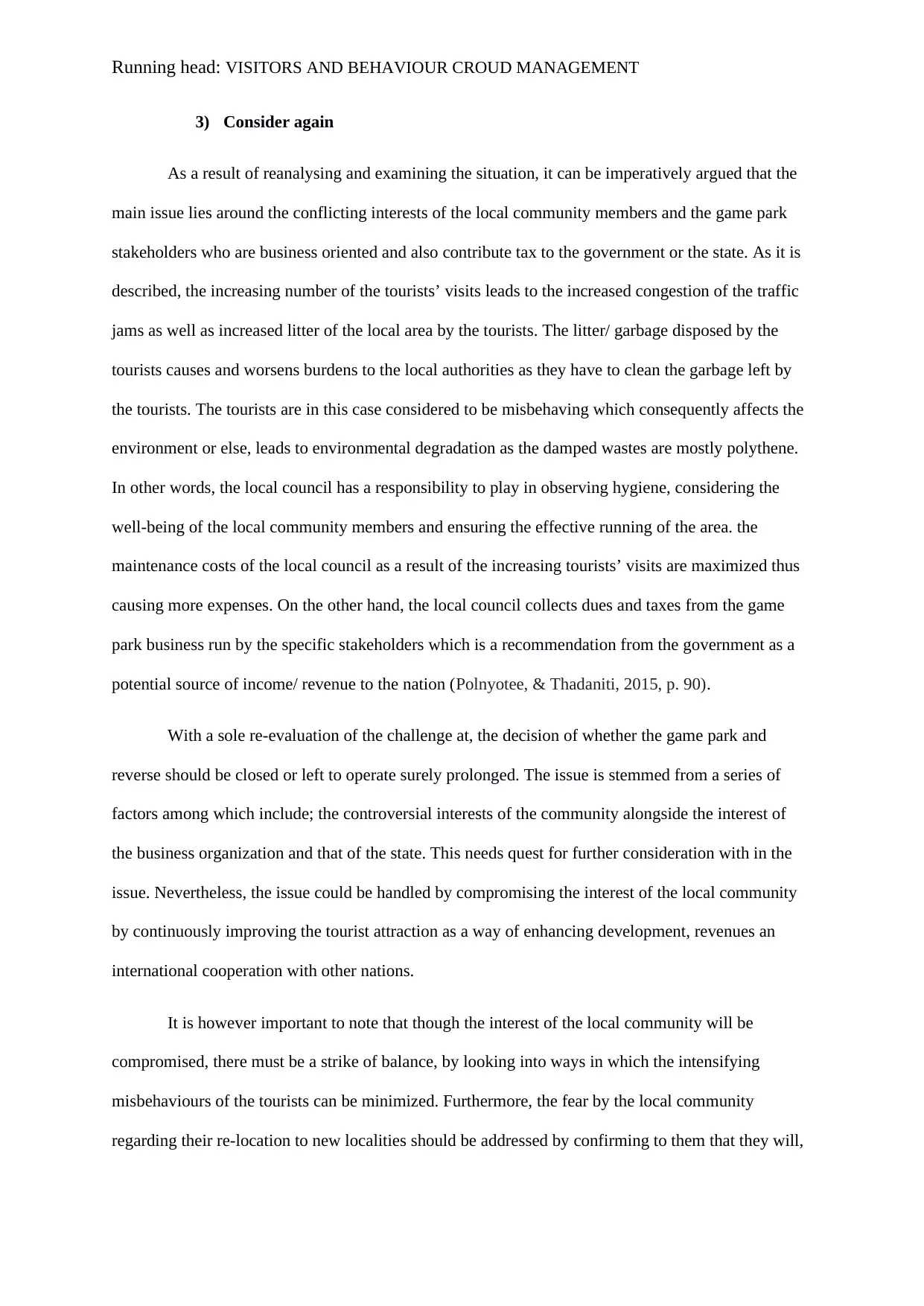
Running head: VISITORS AND BEHAVIOUR CROUD MANAGEMENT
3) Consider again
As a result of reanalysing and examining the situation, it can be imperatively argued that the
main issue lies around the conflicting interests of the local community members and the game park
stakeholders who are business oriented and also contribute tax to the government or the state. As it is
described, the increasing number of the tourists’ visits leads to the increased congestion of the traffic
jams as well as increased litter of the local area by the tourists. The litter/ garbage disposed by the
tourists causes and worsens burdens to the local authorities as they have to clean the garbage left by
the tourists. The tourists are in this case considered to be misbehaving which consequently affects the
environment or else, leads to environmental degradation as the damped wastes are mostly polythene.
In other words, the local council has a responsibility to play in observing hygiene, considering the
well-being of the local community members and ensuring the effective running of the area. the
maintenance costs of the local council as a result of the increasing tourists’ visits are maximized thus
causing more expenses. On the other hand, the local council collects dues and taxes from the game
park business run by the specific stakeholders which is a recommendation from the government as a
potential source of income/ revenue to the nation (Polnyotee, & Thadaniti, 2015, p. 90).
With a sole re-evaluation of the challenge at, the decision of whether the game park and
reverse should be closed or left to operate surely prolonged. The issue is stemmed from a series of
factors among which include; the controversial interests of the community alongside the interest of
the business organization and that of the state. This needs quest for further consideration with in the
issue. Nevertheless, the issue could be handled by compromising the interest of the local community
by continuously improving the tourist attraction as a way of enhancing development, revenues an
international cooperation with other nations.
It is however important to note that though the interest of the local community will be
compromised, there must be a strike of balance, by looking into ways in which the intensifying
misbehaviours of the tourists can be minimized. Furthermore, the fear by the local community
regarding their re-location to new localities should be addressed by confirming to them that they will,
3) Consider again
As a result of reanalysing and examining the situation, it can be imperatively argued that the
main issue lies around the conflicting interests of the local community members and the game park
stakeholders who are business oriented and also contribute tax to the government or the state. As it is
described, the increasing number of the tourists’ visits leads to the increased congestion of the traffic
jams as well as increased litter of the local area by the tourists. The litter/ garbage disposed by the
tourists causes and worsens burdens to the local authorities as they have to clean the garbage left by
the tourists. The tourists are in this case considered to be misbehaving which consequently affects the
environment or else, leads to environmental degradation as the damped wastes are mostly polythene.
In other words, the local council has a responsibility to play in observing hygiene, considering the
well-being of the local community members and ensuring the effective running of the area. the
maintenance costs of the local council as a result of the increasing tourists’ visits are maximized thus
causing more expenses. On the other hand, the local council collects dues and taxes from the game
park business run by the specific stakeholders which is a recommendation from the government as a
potential source of income/ revenue to the nation (Polnyotee, & Thadaniti, 2015, p. 90).
With a sole re-evaluation of the challenge at, the decision of whether the game park and
reverse should be closed or left to operate surely prolonged. The issue is stemmed from a series of
factors among which include; the controversial interests of the community alongside the interest of
the business organization and that of the state. This needs quest for further consideration with in the
issue. Nevertheless, the issue could be handled by compromising the interest of the local community
by continuously improving the tourist attraction as a way of enhancing development, revenues an
international cooperation with other nations.
It is however important to note that though the interest of the local community will be
compromised, there must be a strike of balance, by looking into ways in which the intensifying
misbehaviours of the tourists can be minimized. Furthermore, the fear by the local community
regarding their re-location to new localities should be addressed by confirming to them that they will,
Paraphrase This Document
Need a fresh take? Get an instant paraphrase of this document with our AI Paraphraser
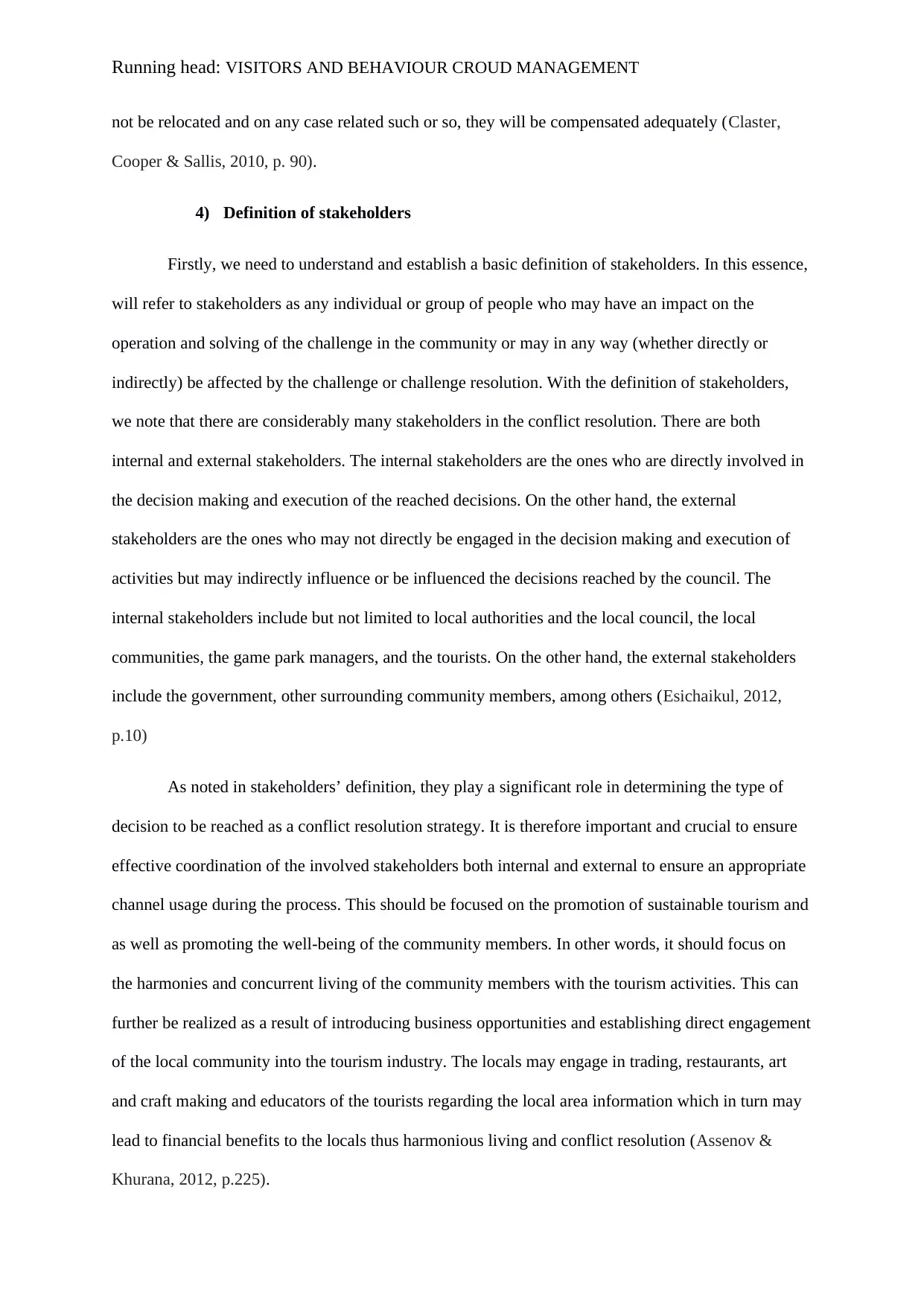
Running head: VISITORS AND BEHAVIOUR CROUD MANAGEMENT
not be relocated and on any case related such or so, they will be compensated adequately (Claster,
Cooper & Sallis, 2010, p. 90).
4) Definition of stakeholders
Firstly, we need to understand and establish a basic definition of stakeholders. In this essence,
will refer to stakeholders as any individual or group of people who may have an impact on the
operation and solving of the challenge in the community or may in any way (whether directly or
indirectly) be affected by the challenge or challenge resolution. With the definition of stakeholders,
we note that there are considerably many stakeholders in the conflict resolution. There are both
internal and external stakeholders. The internal stakeholders are the ones who are directly involved in
the decision making and execution of the reached decisions. On the other hand, the external
stakeholders are the ones who may not directly be engaged in the decision making and execution of
activities but may indirectly influence or be influenced the decisions reached by the council. The
internal stakeholders include but not limited to local authorities and the local council, the local
communities, the game park managers, and the tourists. On the other hand, the external stakeholders
include the government, other surrounding community members, among others (Esichaikul, 2012,
p.10)
As noted in stakeholders’ definition, they play a significant role in determining the type of
decision to be reached as a conflict resolution strategy. It is therefore important and crucial to ensure
effective coordination of the involved stakeholders both internal and external to ensure an appropriate
channel usage during the process. This should be focused on the promotion of sustainable tourism and
as well as promoting the well-being of the community members. In other words, it should focus on
the harmonies and concurrent living of the community members with the tourism activities. This can
further be realized as a result of introducing business opportunities and establishing direct engagement
of the local community into the tourism industry. The locals may engage in trading, restaurants, art
and craft making and educators of the tourists regarding the local area information which in turn may
lead to financial benefits to the locals thus harmonious living and conflict resolution (Assenov &
Khurana, 2012, p.225).
not be relocated and on any case related such or so, they will be compensated adequately (Claster,
Cooper & Sallis, 2010, p. 90).
4) Definition of stakeholders
Firstly, we need to understand and establish a basic definition of stakeholders. In this essence,
will refer to stakeholders as any individual or group of people who may have an impact on the
operation and solving of the challenge in the community or may in any way (whether directly or
indirectly) be affected by the challenge or challenge resolution. With the definition of stakeholders,
we note that there are considerably many stakeholders in the conflict resolution. There are both
internal and external stakeholders. The internal stakeholders are the ones who are directly involved in
the decision making and execution of the reached decisions. On the other hand, the external
stakeholders are the ones who may not directly be engaged in the decision making and execution of
activities but may indirectly influence or be influenced the decisions reached by the council. The
internal stakeholders include but not limited to local authorities and the local council, the local
communities, the game park managers, and the tourists. On the other hand, the external stakeholders
include the government, other surrounding community members, among others (Esichaikul, 2012,
p.10)
As noted in stakeholders’ definition, they play a significant role in determining the type of
decision to be reached as a conflict resolution strategy. It is therefore important and crucial to ensure
effective coordination of the involved stakeholders both internal and external to ensure an appropriate
channel usage during the process. This should be focused on the promotion of sustainable tourism and
as well as promoting the well-being of the community members. In other words, it should focus on
the harmonies and concurrent living of the community members with the tourism activities. This can
further be realized as a result of introducing business opportunities and establishing direct engagement
of the local community into the tourism industry. The locals may engage in trading, restaurants, art
and craft making and educators of the tourists regarding the local area information which in turn may
lead to financial benefits to the locals thus harmonious living and conflict resolution (Assenov &
Khurana, 2012, p.225).
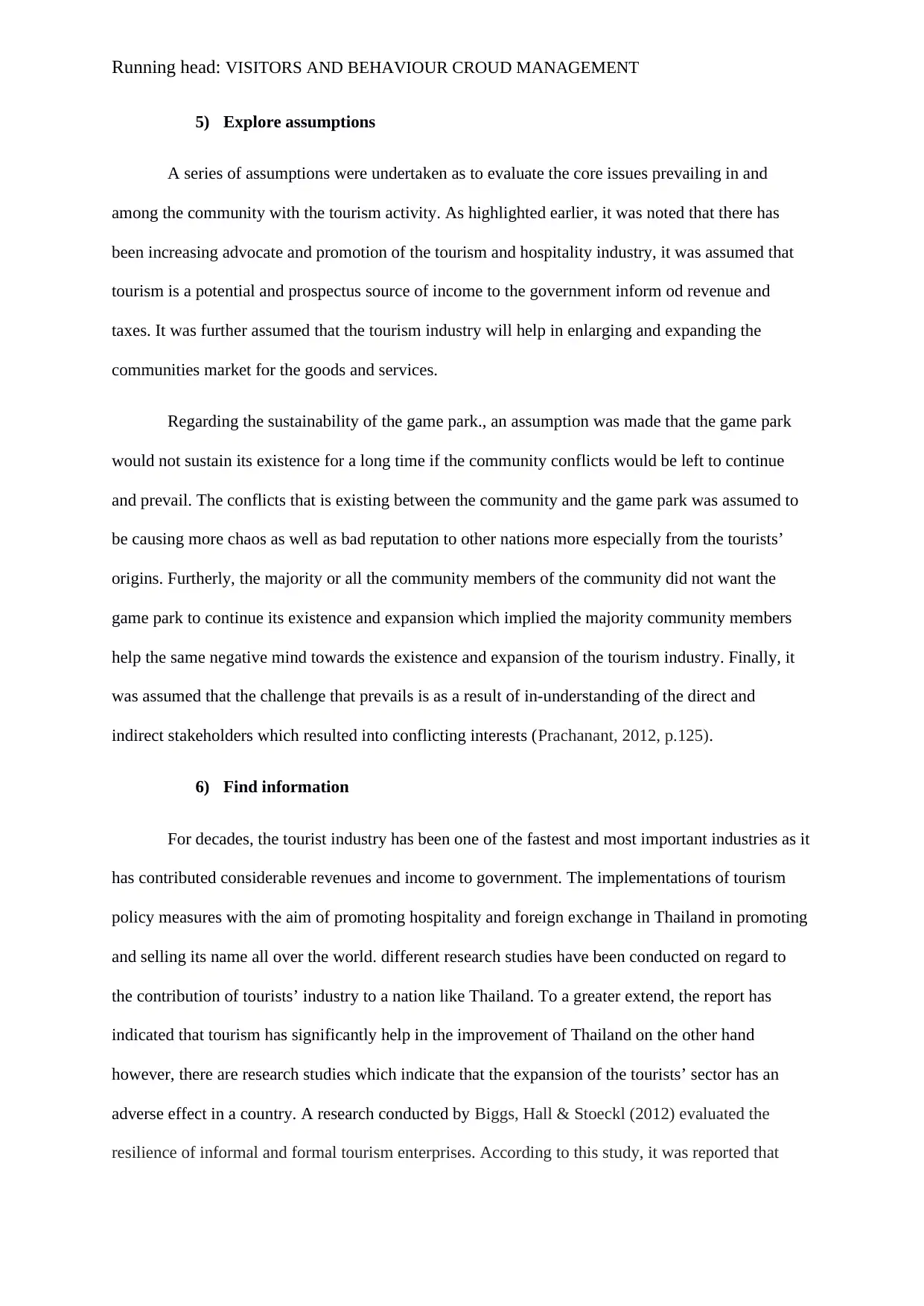
Running head: VISITORS AND BEHAVIOUR CROUD MANAGEMENT
5) Explore assumptions
A series of assumptions were undertaken as to evaluate the core issues prevailing in and
among the community with the tourism activity. As highlighted earlier, it was noted that there has
been increasing advocate and promotion of the tourism and hospitality industry, it was assumed that
tourism is a potential and prospectus source of income to the government inform od revenue and
taxes. It was further assumed that the tourism industry will help in enlarging and expanding the
communities market for the goods and services.
Regarding the sustainability of the game park., an assumption was made that the game park
would not sustain its existence for a long time if the community conflicts would be left to continue
and prevail. The conflicts that is existing between the community and the game park was assumed to
be causing more chaos as well as bad reputation to other nations more especially from the tourists’
origins. Furtherly, the majority or all the community members of the community did not want the
game park to continue its existence and expansion which implied the majority community members
help the same negative mind towards the existence and expansion of the tourism industry. Finally, it
was assumed that the challenge that prevails is as a result of in-understanding of the direct and
indirect stakeholders which resulted into conflicting interests (Prachanant, 2012, p.125).
6) Find information
For decades, the tourist industry has been one of the fastest and most important industries as it
has contributed considerable revenues and income to government. The implementations of tourism
policy measures with the aim of promoting hospitality and foreign exchange in Thailand in promoting
and selling its name all over the world. different research studies have been conducted on regard to
the contribution of tourists’ industry to a nation like Thailand. To a greater extend, the report has
indicated that tourism has significantly help in the improvement of Thailand on the other hand
however, there are research studies which indicate that the expansion of the tourists’ sector has an
adverse effect in a country. A research conducted by Biggs, Hall & Stoeckl (2012) evaluated the
resilience of informal and formal tourism enterprises. According to this study, it was reported that
5) Explore assumptions
A series of assumptions were undertaken as to evaluate the core issues prevailing in and
among the community with the tourism activity. As highlighted earlier, it was noted that there has
been increasing advocate and promotion of the tourism and hospitality industry, it was assumed that
tourism is a potential and prospectus source of income to the government inform od revenue and
taxes. It was further assumed that the tourism industry will help in enlarging and expanding the
communities market for the goods and services.
Regarding the sustainability of the game park., an assumption was made that the game park
would not sustain its existence for a long time if the community conflicts would be left to continue
and prevail. The conflicts that is existing between the community and the game park was assumed to
be causing more chaos as well as bad reputation to other nations more especially from the tourists’
origins. Furtherly, the majority or all the community members of the community did not want the
game park to continue its existence and expansion which implied the majority community members
help the same negative mind towards the existence and expansion of the tourism industry. Finally, it
was assumed that the challenge that prevails is as a result of in-understanding of the direct and
indirect stakeholders which resulted into conflicting interests (Prachanant, 2012, p.125).
6) Find information
For decades, the tourist industry has been one of the fastest and most important industries as it
has contributed considerable revenues and income to government. The implementations of tourism
policy measures with the aim of promoting hospitality and foreign exchange in Thailand in promoting
and selling its name all over the world. different research studies have been conducted on regard to
the contribution of tourists’ industry to a nation like Thailand. To a greater extend, the report has
indicated that tourism has significantly help in the improvement of Thailand on the other hand
however, there are research studies which indicate that the expansion of the tourists’ sector has an
adverse effect in a country. A research conducted by Biggs, Hall & Stoeckl (2012) evaluated the
resilience of informal and formal tourism enterprises. According to this study, it was reported that
⊘ This is a preview!⊘
Do you want full access?
Subscribe today to unlock all pages.

Trusted by 1+ million students worldwide
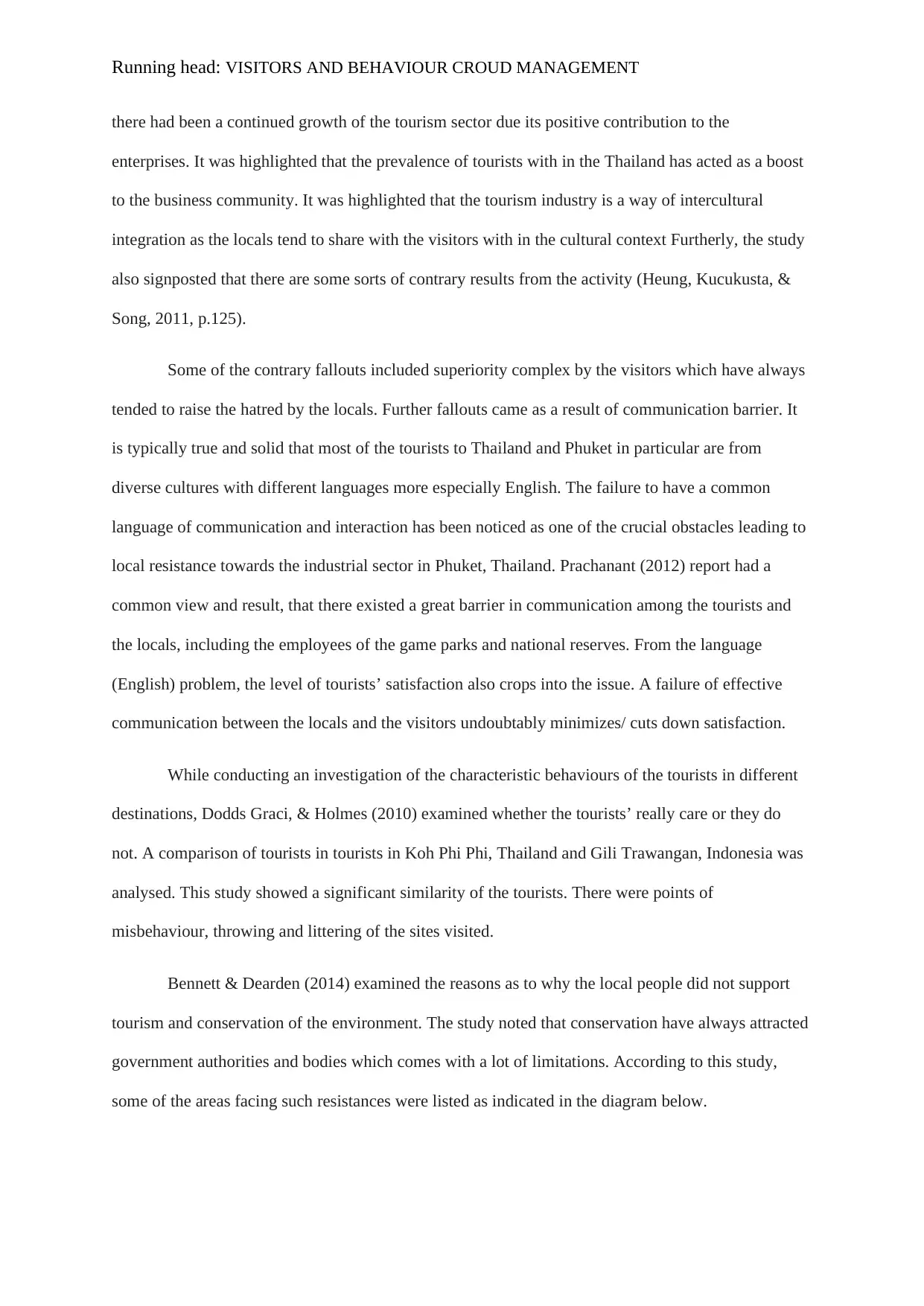
Running head: VISITORS AND BEHAVIOUR CROUD MANAGEMENT
there had been a continued growth of the tourism sector due its positive contribution to the
enterprises. It was highlighted that the prevalence of tourists with in the Thailand has acted as a boost
to the business community. It was highlighted that the tourism industry is a way of intercultural
integration as the locals tend to share with the visitors with in the cultural context Furtherly, the study
also signposted that there are some sorts of contrary results from the activity (Heung, Kucukusta, &
Song, 2011, p.125).
Some of the contrary fallouts included superiority complex by the visitors which have always
tended to raise the hatred by the locals. Further fallouts came as a result of communication barrier. It
is typically true and solid that most of the tourists to Thailand and Phuket in particular are from
diverse cultures with different languages more especially English. The failure to have a common
language of communication and interaction has been noticed as one of the crucial obstacles leading to
local resistance towards the industrial sector in Phuket, Thailand. Prachanant (2012) report had a
common view and result, that there existed a great barrier in communication among the tourists and
the locals, including the employees of the game parks and national reserves. From the language
(English) problem, the level of tourists’ satisfaction also crops into the issue. A failure of effective
communication between the locals and the visitors undoubtably minimizes/ cuts down satisfaction.
While conducting an investigation of the characteristic behaviours of the tourists in different
destinations, Dodds Graci, & Holmes (2010) examined whether the tourists’ really care or they do
not. A comparison of tourists in tourists in Koh Phi Phi, Thailand and Gili Trawangan, Indonesia was
analysed. This study showed a significant similarity of the tourists. There were points of
misbehaviour, throwing and littering of the sites visited.
Bennett & Dearden (2014) examined the reasons as to why the local people did not support
tourism and conservation of the environment. The study noted that conservation have always attracted
government authorities and bodies which comes with a lot of limitations. According to this study,
some of the areas facing such resistances were listed as indicated in the diagram below.
there had been a continued growth of the tourism sector due its positive contribution to the
enterprises. It was highlighted that the prevalence of tourists with in the Thailand has acted as a boost
to the business community. It was highlighted that the tourism industry is a way of intercultural
integration as the locals tend to share with the visitors with in the cultural context Furtherly, the study
also signposted that there are some sorts of contrary results from the activity (Heung, Kucukusta, &
Song, 2011, p.125).
Some of the contrary fallouts included superiority complex by the visitors which have always
tended to raise the hatred by the locals. Further fallouts came as a result of communication barrier. It
is typically true and solid that most of the tourists to Thailand and Phuket in particular are from
diverse cultures with different languages more especially English. The failure to have a common
language of communication and interaction has been noticed as one of the crucial obstacles leading to
local resistance towards the industrial sector in Phuket, Thailand. Prachanant (2012) report had a
common view and result, that there existed a great barrier in communication among the tourists and
the locals, including the employees of the game parks and national reserves. From the language
(English) problem, the level of tourists’ satisfaction also crops into the issue. A failure of effective
communication between the locals and the visitors undoubtably minimizes/ cuts down satisfaction.
While conducting an investigation of the characteristic behaviours of the tourists in different
destinations, Dodds Graci, & Holmes (2010) examined whether the tourists’ really care or they do
not. A comparison of tourists in tourists in Koh Phi Phi, Thailand and Gili Trawangan, Indonesia was
analysed. This study showed a significant similarity of the tourists. There were points of
misbehaviour, throwing and littering of the sites visited.
Bennett & Dearden (2014) examined the reasons as to why the local people did not support
tourism and conservation of the environment. The study noted that conservation have always attracted
government authorities and bodies which comes with a lot of limitations. According to this study,
some of the areas facing such resistances were listed as indicated in the diagram below.
Paraphrase This Document
Need a fresh take? Get an instant paraphrase of this document with our AI Paraphraser
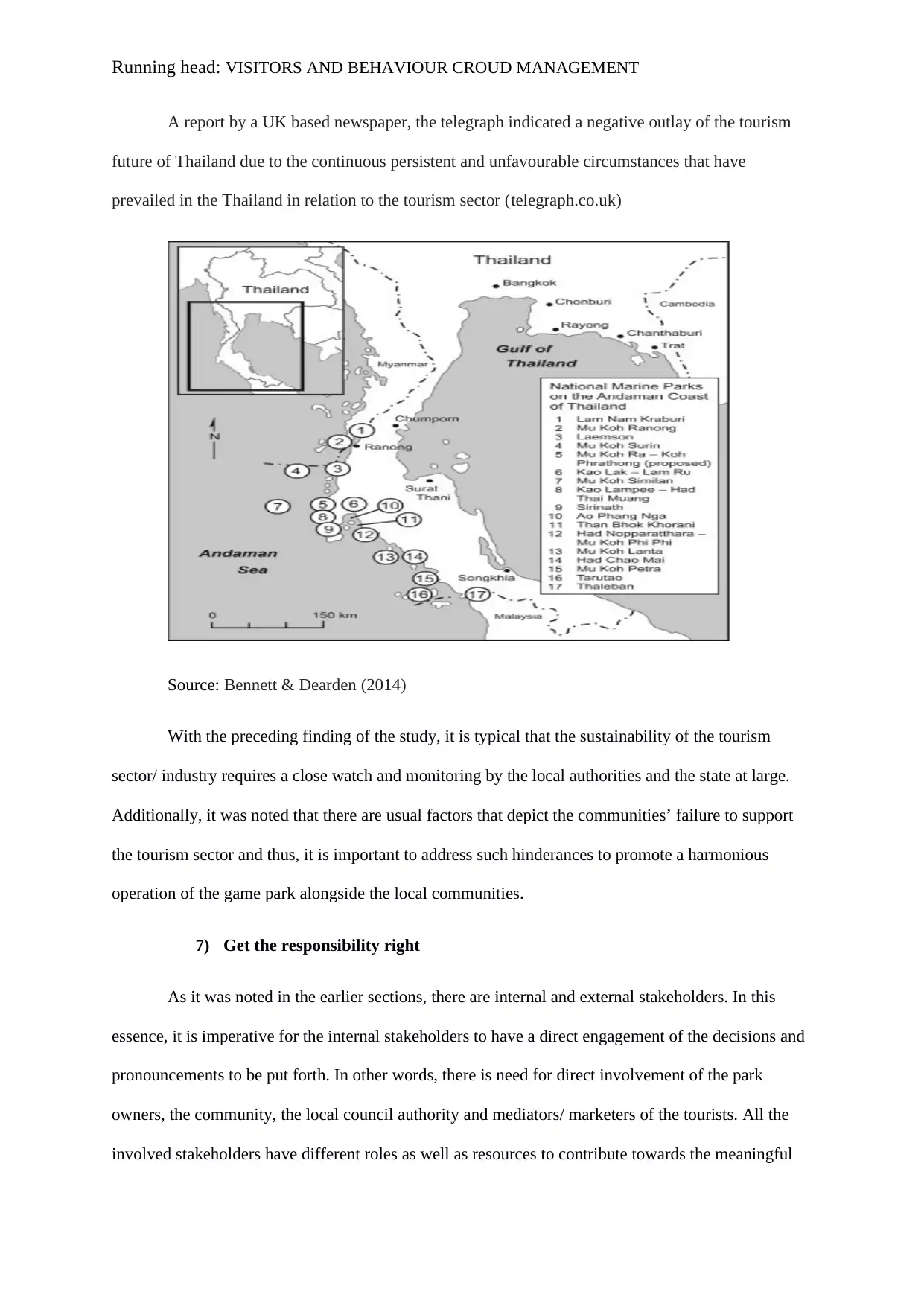
Running head: VISITORS AND BEHAVIOUR CROUD MANAGEMENT
A report by a UK based newspaper, the telegraph indicated a negative outlay of the tourism
future of Thailand due to the continuous persistent and unfavourable circumstances that have
prevailed in the Thailand in relation to the tourism sector (telegraph.co.uk)
Source: Bennett & Dearden (2014)
With the preceding finding of the study, it is typical that the sustainability of the tourism
sector/ industry requires a close watch and monitoring by the local authorities and the state at large.
Additionally, it was noted that there are usual factors that depict the communities’ failure to support
the tourism sector and thus, it is important to address such hinderances to promote a harmonious
operation of the game park alongside the local communities.
7) Get the responsibility right
As it was noted in the earlier sections, there are internal and external stakeholders. In this
essence, it is imperative for the internal stakeholders to have a direct engagement of the decisions and
pronouncements to be put forth. In other words, there is need for direct involvement of the park
owners, the community, the local council authority and mediators/ marketers of the tourists. All the
involved stakeholders have different roles as well as resources to contribute towards the meaningful
A report by a UK based newspaper, the telegraph indicated a negative outlay of the tourism
future of Thailand due to the continuous persistent and unfavourable circumstances that have
prevailed in the Thailand in relation to the tourism sector (telegraph.co.uk)
Source: Bennett & Dearden (2014)
With the preceding finding of the study, it is typical that the sustainability of the tourism
sector/ industry requires a close watch and monitoring by the local authorities and the state at large.
Additionally, it was noted that there are usual factors that depict the communities’ failure to support
the tourism sector and thus, it is important to address such hinderances to promote a harmonious
operation of the game park alongside the local communities.
7) Get the responsibility right
As it was noted in the earlier sections, there are internal and external stakeholders. In this
essence, it is imperative for the internal stakeholders to have a direct engagement of the decisions and
pronouncements to be put forth. In other words, there is need for direct involvement of the park
owners, the community, the local council authority and mediators/ marketers of the tourists. All the
involved stakeholders have different roles as well as resources to contribute towards the meaningful
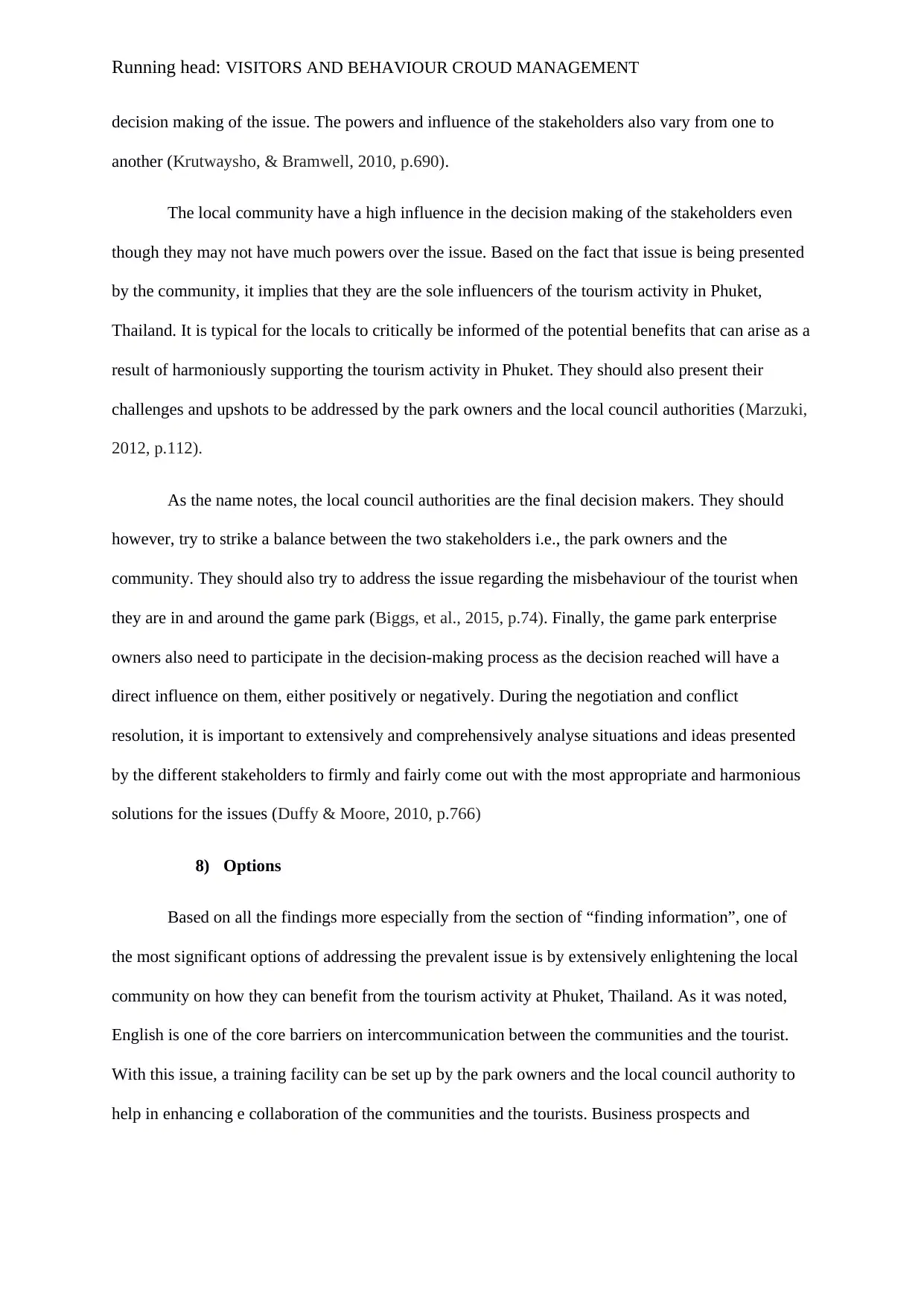
Running head: VISITORS AND BEHAVIOUR CROUD MANAGEMENT
decision making of the issue. The powers and influence of the stakeholders also vary from one to
another (Krutwaysho, & Bramwell, 2010, p.690).
The local community have a high influence in the decision making of the stakeholders even
though they may not have much powers over the issue. Based on the fact that issue is being presented
by the community, it implies that they are the sole influencers of the tourism activity in Phuket,
Thailand. It is typical for the locals to critically be informed of the potential benefits that can arise as a
result of harmoniously supporting the tourism activity in Phuket. They should also present their
challenges and upshots to be addressed by the park owners and the local council authorities (Marzuki,
2012, p.112).
As the name notes, the local council authorities are the final decision makers. They should
however, try to strike a balance between the two stakeholders i.e., the park owners and the
community. They should also try to address the issue regarding the misbehaviour of the tourist when
they are in and around the game park (Biggs, et al., 2015, p.74). Finally, the game park enterprise
owners also need to participate in the decision-making process as the decision reached will have a
direct influence on them, either positively or negatively. During the negotiation and conflict
resolution, it is important to extensively and comprehensively analyse situations and ideas presented
by the different stakeholders to firmly and fairly come out with the most appropriate and harmonious
solutions for the issues (Duffy & Moore, 2010, p.766)
8) Options
Based on all the findings more especially from the section of “finding information”, one of
the most significant options of addressing the prevalent issue is by extensively enlightening the local
community on how they can benefit from the tourism activity at Phuket, Thailand. As it was noted,
English is one of the core barriers on intercommunication between the communities and the tourist.
With this issue, a training facility can be set up by the park owners and the local council authority to
help in enhancing e collaboration of the communities and the tourists. Business prospects and
decision making of the issue. The powers and influence of the stakeholders also vary from one to
another (Krutwaysho, & Bramwell, 2010, p.690).
The local community have a high influence in the decision making of the stakeholders even
though they may not have much powers over the issue. Based on the fact that issue is being presented
by the community, it implies that they are the sole influencers of the tourism activity in Phuket,
Thailand. It is typical for the locals to critically be informed of the potential benefits that can arise as a
result of harmoniously supporting the tourism activity in Phuket. They should also present their
challenges and upshots to be addressed by the park owners and the local council authorities (Marzuki,
2012, p.112).
As the name notes, the local council authorities are the final decision makers. They should
however, try to strike a balance between the two stakeholders i.e., the park owners and the
community. They should also try to address the issue regarding the misbehaviour of the tourist when
they are in and around the game park (Biggs, et al., 2015, p.74). Finally, the game park enterprise
owners also need to participate in the decision-making process as the decision reached will have a
direct influence on them, either positively or negatively. During the negotiation and conflict
resolution, it is important to extensively and comprehensively analyse situations and ideas presented
by the different stakeholders to firmly and fairly come out with the most appropriate and harmonious
solutions for the issues (Duffy & Moore, 2010, p.766)
8) Options
Based on all the findings more especially from the section of “finding information”, one of
the most significant options of addressing the prevalent issue is by extensively enlightening the local
community on how they can benefit from the tourism activity at Phuket, Thailand. As it was noted,
English is one of the core barriers on intercommunication between the communities and the tourist.
With this issue, a training facility can be set up by the park owners and the local council authority to
help in enhancing e collaboration of the communities and the tourists. Business prospects and
⊘ This is a preview!⊘
Do you want full access?
Subscribe today to unlock all pages.

Trusted by 1+ million students worldwide
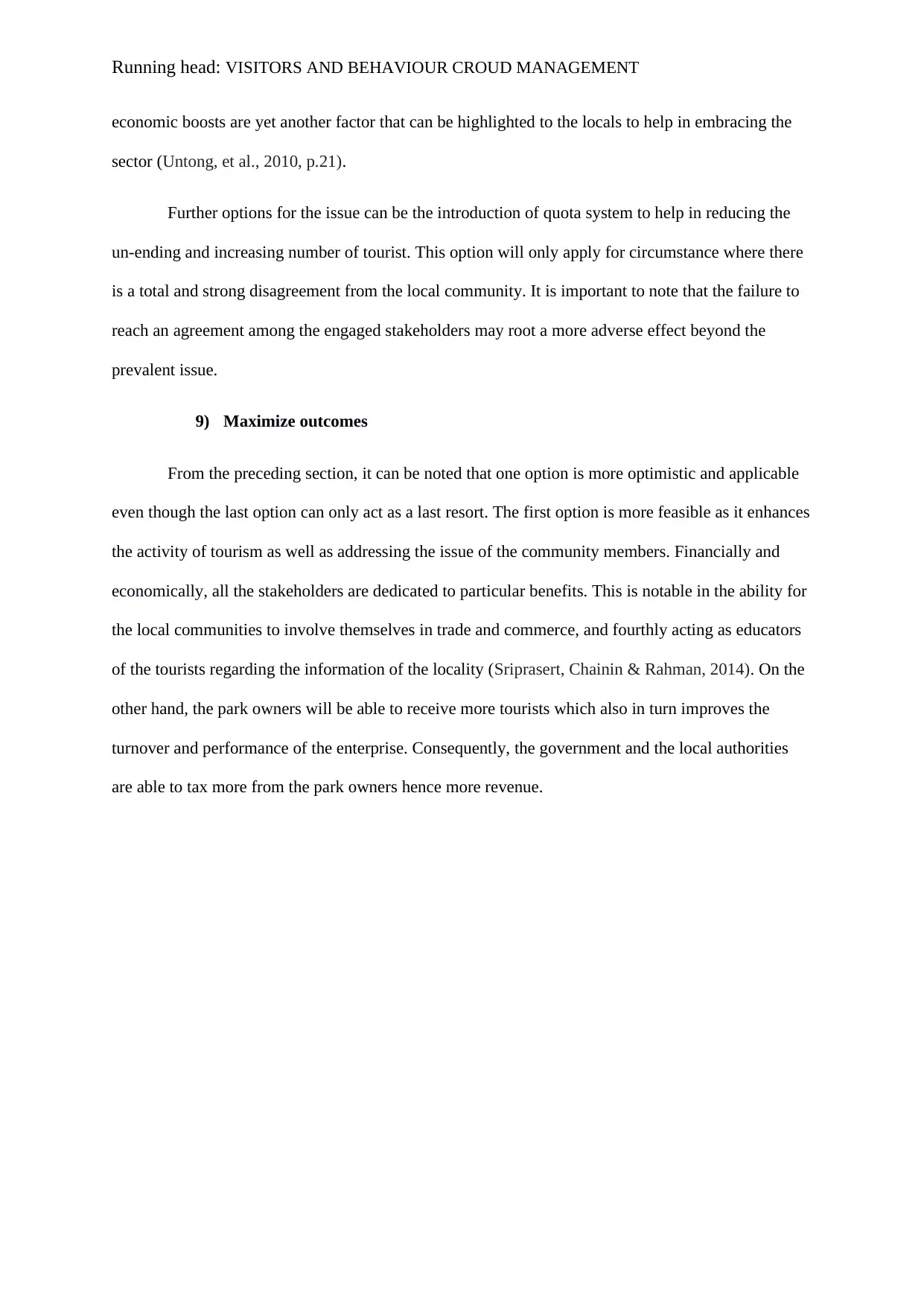
Running head: VISITORS AND BEHAVIOUR CROUD MANAGEMENT
economic boosts are yet another factor that can be highlighted to the locals to help in embracing the
sector (Untong, et al., 2010, p.21).
Further options for the issue can be the introduction of quota system to help in reducing the
un-ending and increasing number of tourist. This option will only apply for circumstance where there
is a total and strong disagreement from the local community. It is important to note that the failure to
reach an agreement among the engaged stakeholders may root a more adverse effect beyond the
prevalent issue.
9) Maximize outcomes
From the preceding section, it can be noted that one option is more optimistic and applicable
even though the last option can only act as a last resort. The first option is more feasible as it enhances
the activity of tourism as well as addressing the issue of the community members. Financially and
economically, all the stakeholders are dedicated to particular benefits. This is notable in the ability for
the local communities to involve themselves in trade and commerce, and fourthly acting as educators
of the tourists regarding the information of the locality (Sriprasert, Chainin & Rahman, 2014). On the
other hand, the park owners will be able to receive more tourists which also in turn improves the
turnover and performance of the enterprise. Consequently, the government and the local authorities
are able to tax more from the park owners hence more revenue.
economic boosts are yet another factor that can be highlighted to the locals to help in embracing the
sector (Untong, et al., 2010, p.21).
Further options for the issue can be the introduction of quota system to help in reducing the
un-ending and increasing number of tourist. This option will only apply for circumstance where there
is a total and strong disagreement from the local community. It is important to note that the failure to
reach an agreement among the engaged stakeholders may root a more adverse effect beyond the
prevalent issue.
9) Maximize outcomes
From the preceding section, it can be noted that one option is more optimistic and applicable
even though the last option can only act as a last resort. The first option is more feasible as it enhances
the activity of tourism as well as addressing the issue of the community members. Financially and
economically, all the stakeholders are dedicated to particular benefits. This is notable in the ability for
the local communities to involve themselves in trade and commerce, and fourthly acting as educators
of the tourists regarding the information of the locality (Sriprasert, Chainin & Rahman, 2014). On the
other hand, the park owners will be able to receive more tourists which also in turn improves the
turnover and performance of the enterprise. Consequently, the government and the local authorities
are able to tax more from the park owners hence more revenue.
Paraphrase This Document
Need a fresh take? Get an instant paraphrase of this document with our AI Paraphraser
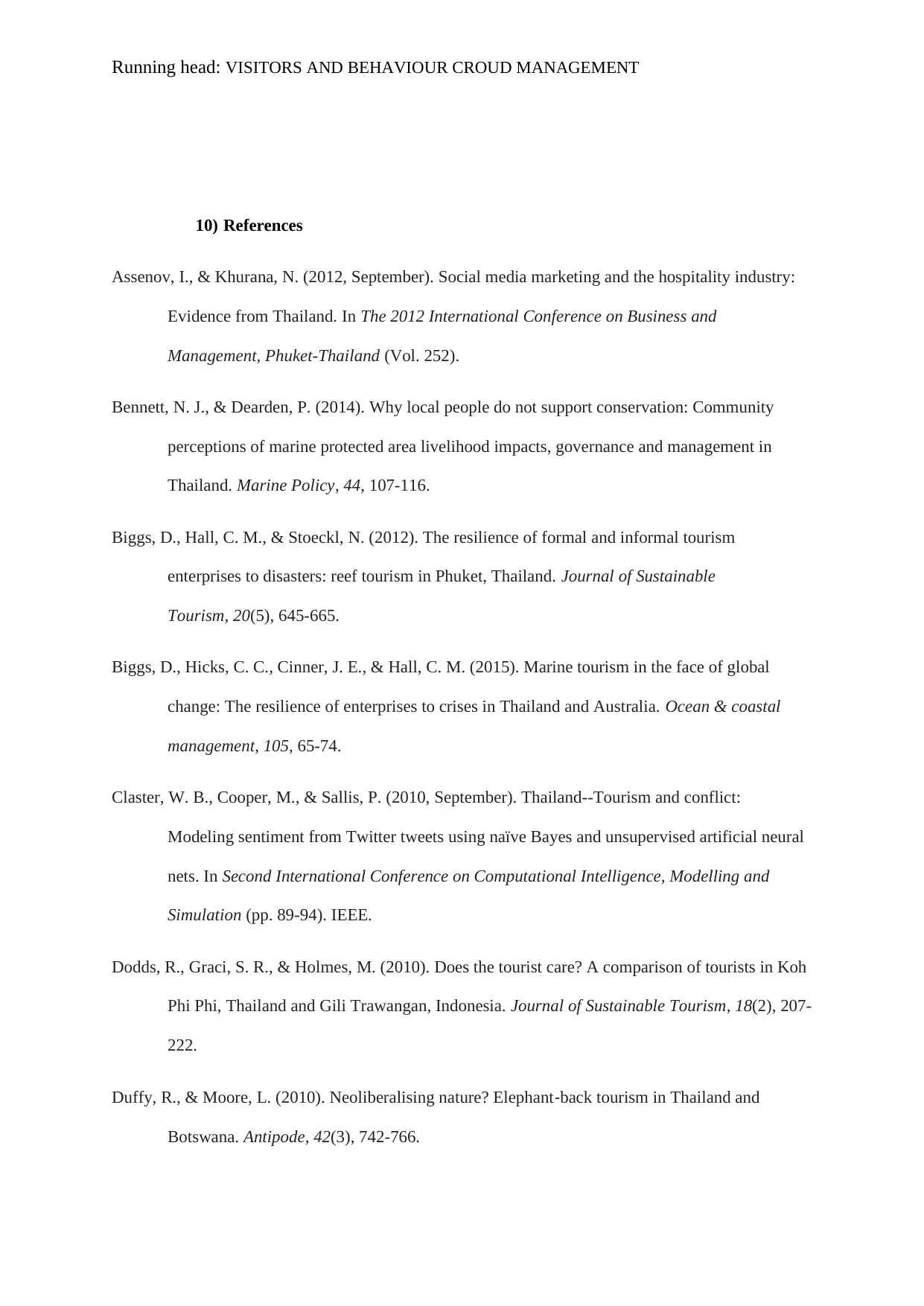
Running head: VISITORS AND BEHAVIOUR CROUD MANAGEMENT
10) References
Assenov, I., & Khurana, N. (2012, September). Social media marketing and the hospitality industry:
Evidence from Thailand. In The 2012 International Conference on Business and
Management, Phuket-Thailand (Vol. 252).
Bennett, N. J., & Dearden, P. (2014). Why local people do not support conservation: Community
perceptions of marine protected area livelihood impacts, governance and management in
Thailand. Marine Policy, 44, 107-116.
Biggs, D., Hall, C. M., & Stoeckl, N. (2012). The resilience of formal and informal tourism
enterprises to disasters: reef tourism in Phuket, Thailand. Journal of Sustainable
Tourism, 20(5), 645-665.
Biggs, D., Hicks, C. C., Cinner, J. E., & Hall, C. M. (2015). Marine tourism in the face of global
change: The resilience of enterprises to crises in Thailand and Australia. Ocean & coastal
management, 105, 65-74.
Claster, W. B., Cooper, M., & Sallis, P. (2010, September). Thailand--Tourism and conflict:
Modeling sentiment from Twitter tweets using naïve Bayes and unsupervised artificial neural
nets. In Second International Conference on Computational Intelligence, Modelling and
Simulation (pp. 89-94). IEEE.
Dodds, R., Graci, S. R., & Holmes, M. (2010). Does the tourist care? A comparison of tourists in Koh
Phi Phi, Thailand and Gili Trawangan, Indonesia. Journal of Sustainable Tourism, 18(2), 207-
222.
Duffy, R., & Moore, L. (2010). Neoliberalising nature? Elephant‐back tourism in Thailand and
Botswana. Antipode, 42(3), 742-766.
10) References
Assenov, I., & Khurana, N. (2012, September). Social media marketing and the hospitality industry:
Evidence from Thailand. In The 2012 International Conference on Business and
Management, Phuket-Thailand (Vol. 252).
Bennett, N. J., & Dearden, P. (2014). Why local people do not support conservation: Community
perceptions of marine protected area livelihood impacts, governance and management in
Thailand. Marine Policy, 44, 107-116.
Biggs, D., Hall, C. M., & Stoeckl, N. (2012). The resilience of formal and informal tourism
enterprises to disasters: reef tourism in Phuket, Thailand. Journal of Sustainable
Tourism, 20(5), 645-665.
Biggs, D., Hicks, C. C., Cinner, J. E., & Hall, C. M. (2015). Marine tourism in the face of global
change: The resilience of enterprises to crises in Thailand and Australia. Ocean & coastal
management, 105, 65-74.
Claster, W. B., Cooper, M., & Sallis, P. (2010, September). Thailand--Tourism and conflict:
Modeling sentiment from Twitter tweets using naïve Bayes and unsupervised artificial neural
nets. In Second International Conference on Computational Intelligence, Modelling and
Simulation (pp. 89-94). IEEE.
Dodds, R., Graci, S. R., & Holmes, M. (2010). Does the tourist care? A comparison of tourists in Koh
Phi Phi, Thailand and Gili Trawangan, Indonesia. Journal of Sustainable Tourism, 18(2), 207-
222.
Duffy, R., & Moore, L. (2010). Neoliberalising nature? Elephant‐back tourism in Thailand and
Botswana. Antipode, 42(3), 742-766.
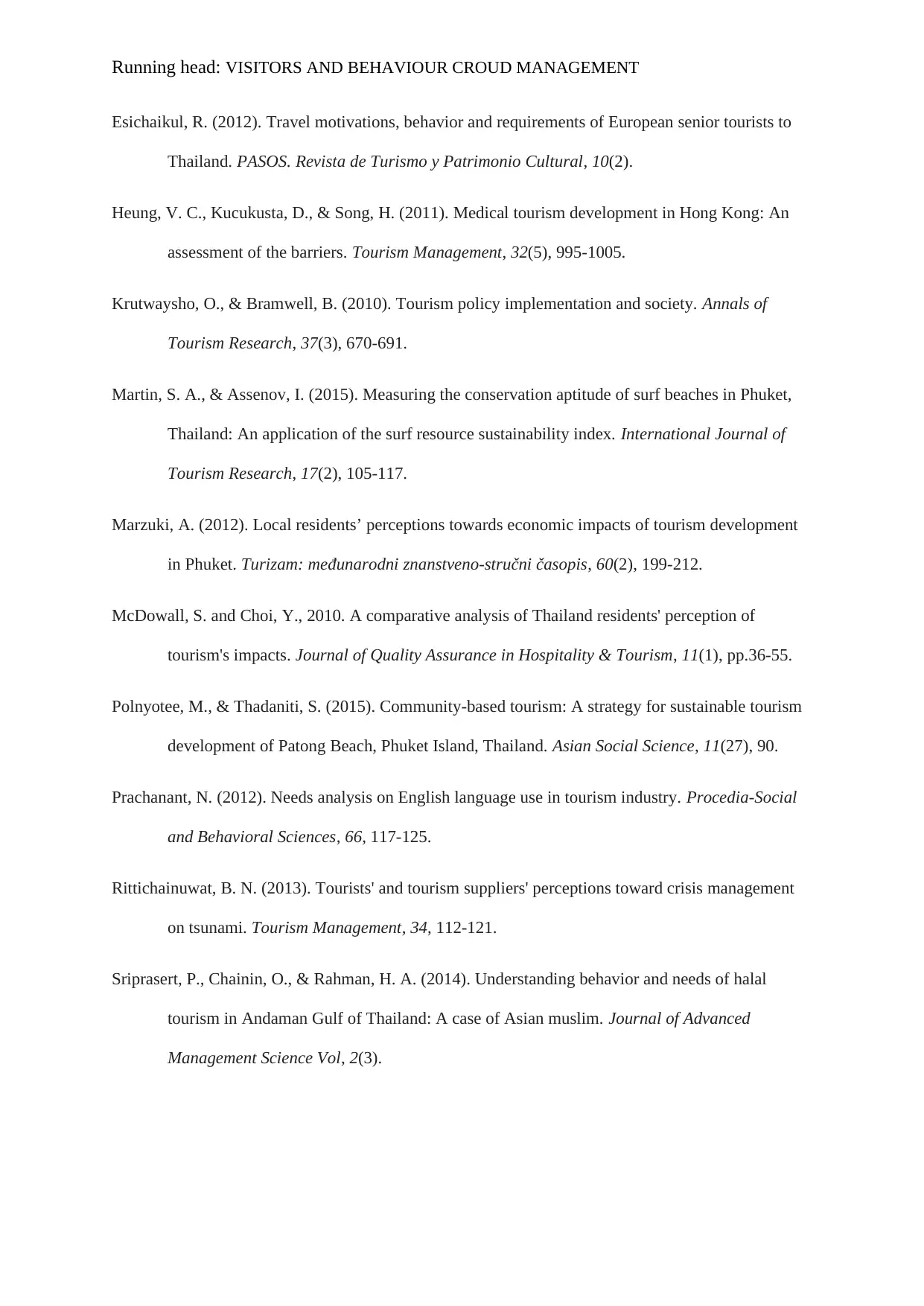
Running head: VISITORS AND BEHAVIOUR CROUD MANAGEMENT
Esichaikul, R. (2012). Travel motivations, behavior and requirements of European senior tourists to
Thailand. PASOS. Revista de Turismo y Patrimonio Cultural, 10(2).
Heung, V. C., Kucukusta, D., & Song, H. (2011). Medical tourism development in Hong Kong: An
assessment of the barriers. Tourism Management, 32(5), 995-1005.
Krutwaysho, O., & Bramwell, B. (2010). Tourism policy implementation and society. Annals of
Tourism Research, 37(3), 670-691.
Martin, S. A., & Assenov, I. (2015). Measuring the conservation aptitude of surf beaches in Phuket,
Thailand: An application of the surf resource sustainability index. International Journal of
Tourism Research, 17(2), 105-117.
Marzuki, A. (2012). Local residents’ perceptions towards economic impacts of tourism development
in Phuket. Turizam: međunarodni znanstveno-stručni časopis, 60(2), 199-212.
McDowall, S. and Choi, Y., 2010. A comparative analysis of Thailand residents' perception of
tourism's impacts. Journal of Quality Assurance in Hospitality & Tourism, 11(1), pp.36-55.
Polnyotee, M., & Thadaniti, S. (2015). Community-based tourism: A strategy for sustainable tourism
development of Patong Beach, Phuket Island, Thailand. Asian Social Science, 11(27), 90.
Prachanant, N. (2012). Needs analysis on English language use in tourism industry. Procedia-Social
and Behavioral Sciences, 66, 117-125.
Rittichainuwat, B. N. (2013). Tourists' and tourism suppliers' perceptions toward crisis management
on tsunami. Tourism Management, 34, 112-121.
Sriprasert, P., Chainin, O., & Rahman, H. A. (2014). Understanding behavior and needs of halal
tourism in Andaman Gulf of Thailand: A case of Asian muslim. Journal of Advanced
Management Science Vol, 2(3).
Esichaikul, R. (2012). Travel motivations, behavior and requirements of European senior tourists to
Thailand. PASOS. Revista de Turismo y Patrimonio Cultural, 10(2).
Heung, V. C., Kucukusta, D., & Song, H. (2011). Medical tourism development in Hong Kong: An
assessment of the barriers. Tourism Management, 32(5), 995-1005.
Krutwaysho, O., & Bramwell, B. (2010). Tourism policy implementation and society. Annals of
Tourism Research, 37(3), 670-691.
Martin, S. A., & Assenov, I. (2015). Measuring the conservation aptitude of surf beaches in Phuket,
Thailand: An application of the surf resource sustainability index. International Journal of
Tourism Research, 17(2), 105-117.
Marzuki, A. (2012). Local residents’ perceptions towards economic impacts of tourism development
in Phuket. Turizam: međunarodni znanstveno-stručni časopis, 60(2), 199-212.
McDowall, S. and Choi, Y., 2010. A comparative analysis of Thailand residents' perception of
tourism's impacts. Journal of Quality Assurance in Hospitality & Tourism, 11(1), pp.36-55.
Polnyotee, M., & Thadaniti, S. (2015). Community-based tourism: A strategy for sustainable tourism
development of Patong Beach, Phuket Island, Thailand. Asian Social Science, 11(27), 90.
Prachanant, N. (2012). Needs analysis on English language use in tourism industry. Procedia-Social
and Behavioral Sciences, 66, 117-125.
Rittichainuwat, B. N. (2013). Tourists' and tourism suppliers' perceptions toward crisis management
on tsunami. Tourism Management, 34, 112-121.
Sriprasert, P., Chainin, O., & Rahman, H. A. (2014). Understanding behavior and needs of halal
tourism in Andaman Gulf of Thailand: A case of Asian muslim. Journal of Advanced
Management Science Vol, 2(3).
⊘ This is a preview!⊘
Do you want full access?
Subscribe today to unlock all pages.

Trusted by 1+ million students worldwide
1 out of 13
Related Documents
Your All-in-One AI-Powered Toolkit for Academic Success.
+13062052269
info@desklib.com
Available 24*7 on WhatsApp / Email
![[object Object]](/_next/static/media/star-bottom.7253800d.svg)
Unlock your academic potential
Copyright © 2020–2025 A2Z Services. All Rights Reserved. Developed and managed by ZUCOL.




